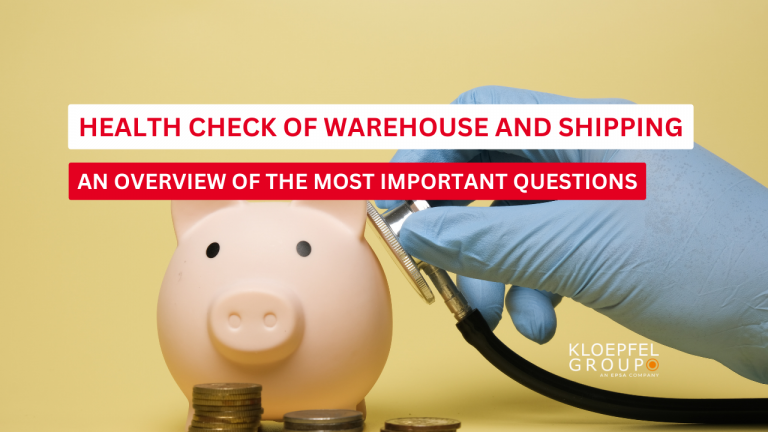Why is a potential analysis of warehouse and shipping departments, the so-called Health-Check, important?
As part of the Health-Check, our customers receive an overview of their costs for shipping and warehousing. The turnover rate also serves as a significant and useful indicator for the purchasing department. Examining warehouse metrics goes hand-in-hand with analyzing the workflows of the shipping department. This reveals where workflows interlink and how they contribute to the overall result of the goods flow.
This holistic view includes current, objective benchmarks that clearly highlight potential savings. It also reveals opportunities to improve the overall performance of the supply chain.
Overall, the goal of the Health-Check for the warehouse and shipping department is to identify potential improvements and corresponding optimization measures for the customer. Ultimately, the customer receives data-driven results that serve as a decision-making basis both financially and in terms of processes.
What savings are possible?
On average, the projects achieve savings of about 10 percent. The areas of warehouse logistics and shipping department are usually considered separately. As a result, the total savings often become significantly higher.
When should a Health-Check of your warehouse and shipping be conducted?
A Health-Check should be conducted as early as possible. The sooner you identify potentials, the sooner you can implement them.
For example, there are annual contracts for various services such as warehouse logistics or intralogistics. In this case, it is advisable to conduct such a potential analysis as quickly as possible to keep an overview and leverage market price developments to your advantage. Moreover, the operational area often requires more time for changes and process adjustments.
How are data collected for the analysis?
Since we work in a practical manner, we collect data in two ways.
Firstly, data collection involves reviewing documents from the respective departments. We closely examine the facts from the areas of warehousing, transport, and shipping.
Secondly, we observe the operational work for one to two days. This is necessary to get a clearer picture and better understanding of daily operations. During this process, we also ask specific questions to the professional staff.
In the warehouse, all threads of a company converge. Often, during practical observation, we recognize specific examples of improvements in other process areas as well. This positively impacts the overall supply chain management, among other things.
The collected data include classic information such as warehouse costs, personnel costs, rental costs for industrial trucks, IT connections, and inventory management systems. To minimize the effort for the customer, we request specific documents and combine this information with our observations into a comprehensive concept.
Of course, confidentiality is maintained through non-disclosure agreements (NDAs). This means that we do not share information with third parties without the customer’s consent.
How long does such a Health-Check take?
The initial step is the data collection process, which can vary significantly in duration. A site visit can occur simultaneously. Once all data are available, their evaluation takes a few more days. On average, we plan a duration of two to three weeks.
How is communication and collaboration with customers structured during the analysis phase?
Our goal is to disrupt the customers’ daily routine as little as possible. Following the motto “as much as necessary, as little as possible,” we work directly with the responsible parties, remaining open and transparent throughout.
We avoid making employees feel monitored. Only through an operational analysis, including the observation of work routines, can a proper result be achieved. The exchange is open and collegial.
How are the Health-Check results presented, and how detailed and reliable are they?
The results of the Health-Check are presented in the form of a very detailed PowerPoint presentation. These presentations visualize the figures and illustrate the relationships. This allows companies to understand exactly how the benchmarks were derived and used as a benchmark for the Health-Check. The results are very accurately derived and reliable. They show short- and long-term savings as well as improvement potentials at a glance.
What are the typical customer reactions when the results are presented?
Typical customer reactions to the presented results vary.
Our analysis has a very operational focus. Sometimes, you encounter employees who fear changes in their daily routine. Here, it is particularly important not to leave these people alone and to make them understand that they have nothing to worry about. Instead, you need to show them the benefits of the optimizations. This helps employees realize that they will face less effort after the respective adjustments.
Such a dialogue usually goes very well because the facts of the Health-Check speak for themselves. Our advice is to involve the relevant departments early on and let them participate in the development process. It is also helpful to allow them to contribute their own ideas.
What steps does Kloepfel 4PL Solutions recommend to companies after the analysis for implementing the results?
After the analysis, we recommend that customers begin a joint consulting project to realize the identified savings potentials. When implementing the recommendations from the potential analysis, we work closely with the customer. This includes negotiations with service providers, creating new process flows, conducting workshops, and the operational implementation of our recommendations.
How is the project success secured long-term?
Project success is secured long-term by providing employees with everything they need. They receive the know-how and the complete toolkit from us, enabling them to independently implement the new standards.
The project process, characterized by transparency and collegial interaction, is beneficial here. Good collaboration between the customer’s employees and Kloepfel 4PL Solutions’ consultants as colleagues and temporary coaches ensures a successful knowledge transfer. This enables the customer’s employees to identify and leverage savings potentials independently in the future.
Freight cost potential analysis: an overview of the most important questions
Contact:
Kloepfel Group
Christopher Willson
Tel.: 0211 941 984 33 | Mail: rendite@kloepfel-consulting.com
